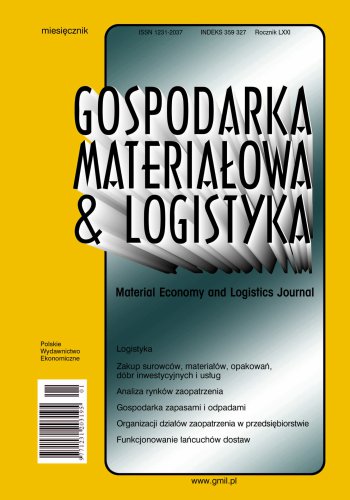Global supply chains' disruptions as a result of the COVID-19 pandemic crisis and the dynamic world container shipping market recovery
Zakłócenia globalnych łańcuchów dostaw wskutek kryzysu wywołanego pandemią COVID-19 oraz dynamicznego ożywienia rynku żeglugi kontenerowej
The world crisis caused by the pandemic exerted significant impact on the global supply chain operations. They were subjected to numerous unprecedented disturbances which then significantly intensified as a result of the unexpected, dynamic recovery of the global container transport market. The aim of the article is to attempt a multifaceted initial assessment of the scale and widespread results of the destabilization of markets and global logistics supply chains, as well as to determine its impact on the global economy, along with an indication of the possible short- and medium-term consequences of this state for selected entities operating in global supply chains. The main hypotheses which were verified during the study were as followed: (1) the COVID-19 crisis impacted the global commodity and shipping markets with unprecedented and unknown so far force, (2) the global container shipping sector experienced historical boom during the period from October 2020 to March 2022 and was in fact a real financial beneficiary of the last crisis. The methods of economic and statistical analysis and among them the factors analysis (FA) have been used as the main analytical tool to carry out the set research goals and to verify the hypotheses. The results of this study indicate the need for greater control of the global container shipping alliances by antitrust authorities as well as for deeper structural reconstruction of the existed global logistics supply chains.
Światowy kryzys spowodowany pandemią wywarł znaczny wpływ na globalne łańcuchy dostaw. Zostały one poddane licznym, niespotykanym dotychczas zakłóceniom, które następnie nieoczekiwanie nasiliły się w wyniku niespodziewanego, dynamicznego ożywienia globalnego rynku przewozów kontenerowych. Celem artykułu jest podjęcie próby dokonania wstępnej, wieloaspektowej oceny skali i skutków nieznanej dotychczas w historii rozwoju handlu i żeglugi światowej destabilizacji rynków oraz globalnych logistycznych łańcuchów dostaw. Sformułowano dwie hipotezy badawcze, które następnie poddano weryfikacji: (1) kryzys COVID-19 wpłynął na światowe rynki towarowe i żeglugowe z nieznaną i niespotykaną dotychczas siłą, oraz (2) globalny sektor żeglugi kontenerowej doświadczył w trakcie jego trwania w okresie październik 2020–marzec 2022 historycznego boomu i był realnie beneficjentem finansowym ostatniego kryzysu. Metody analizy ekonomiczno- statystycznej, a wśród nich analiza czynnikowa (FA), zostały wykorzystane jako główne narzędzie analityczne do realizacji założonych celów badawczych i weryfikacji postawionych hipotez. Uzyskane wyniki wskazują na potrzebę większej kontroli globalnych kontenerowych aliansów żeglugowych przez organy antymonopolowe, a także głębszej, strukturalnej przebudowy istniejących globalnych logistycznych łańcuchów dostaw.
Bibliografia
References/Bibliografia
Baker McKenzie. (2020). Beyond COVID-19. Supply chain resilience holds key to recovery. Oxford Economics.
Baraniuk, C. (2020). Why only giant ships can't solve the shipping crises. BBC Business News. http:www.bbc.com/mes/business.
CEVA Logistics. (2020). Ocean freight — state of the market. Ceva Logistics. https://www.cevalogistics.com/en
Citi. (2021). Disruption, digitalization, resilience. The future of Asia-Pacific supply chains. Citi Bank NA.
DHL. (2021). Ocean freight market update. DHL Global Forwarding Publication.
Drewry. (2022). Drewry World Container Index. Drewry Supply Chain Advisors. https://www.drewry.co.uk/supply-chainadvisors/supply-chain-expertise
FinancesOnline. (2021). 14 supply chain trends for 2021/2022: New predictions to watch out for. https://financesonline.com/customer-reviews-statistics
Gay du, P., & Morgan, G. (2013). New spirits of capitalism? Crises justification, and dynamics (22–24). Oxford University Press.
Greenspan, A. (2008). The age of turbulence: Adventures in a New World. Penguin Books.
Grzelakowski, A. S. (2022a). Global container shipping operators' strategies under the extremely turbulent market dynamic environment: An analytical approach. European Research Studies Journal, XXV(3), 682–696, https://doi.org/10.35808/ersj/3058
Grzelakowski, A. S. (2022b). Transport morski. W: K. Wojewódzka-Król, & E. Załoga (Red.), Transport: tendencje zmian (418–420). Wydawnictwo Naukowe PWN.
Habert, T., & Braun, S. (2020). Supply chain 2020. Special report. MIT Management Sloan School.
Interos. (2021). Interos annual global supply chain report. https://www.interos.ai/blog/rt
JLL. (2020). Logistics 2030. Navigating a disruptive decade. Warehousing and distribution. Ausburn University Center for Supply Chain Innovation.
Koerber. (2020). The state of supply chain complexity in 2020 is going in. piessconsult.de/en/references/reference-projects/koerber-ag
Leggen T. (2021). The partial closure of one China's biggest ports. BBC Business news. BBC World Service.
Logan, D. (2021). 376 container vessels queuing off ports around the world. BBC Business news. BBC World Service.
Mangan, J., Lalvani, Ch., & Butcher, T. (2009). Global logistics and supply chain management. John Wiley & Sons.
RetailNext. (2021). New predictions. https://retailnext.net/
Roland Berger. (2020). Latest update of our corona economic impact series. https://www.rolandberger.com/en/Insights/Publications/#!?categories.country=Global
S&P Global Platts. (2021). https://www.commoditystats.com/?gclid
Sea-Intelligence. (2020). Sunday Spotlight, (488).
Source Today. (2021a). Port congestion continues to throttle the world's supply chains. https://www.sourcetoday.com/home/document/21251413/supply-chain-disruptions
Source Today. (2021b). US shippers and carriers wrestle with a growing truck drivers shortage. https://www.sourcetoday.com/home/document
Statista. (2021). Transportation & logistics. Statista Research Department. https://de.statista.com
Taleb, N. N. (2008). The Black Swan. The impact on the highly improbable. Second edition. Penguin Books.
UNCTAD. (2020a). COVID-19: A 10-point action plan to strengthen international trade and transport facilitation in times of pandemic. Policy Brief No. 79.
UNCTAD. (2020b). Review of maritime transport 2020. UN Publications.
UNCTAD. (2021). Global trade update. May 2021. UN Publications.
UNCTAD/RMT. (2020). Trade and development report. UN/RMT Publications.
WEF. (2021). The global risks report 2021. 16th edition, https://www.weforum.org/reports/annual-report-2021-2022/
WTO. (2020). International trade and tariff data. https://www.wto.org/english/res_e/publication
WTO. (2021). World trade statistical review 2021. https://www.wto.org/english/res_e/publications

